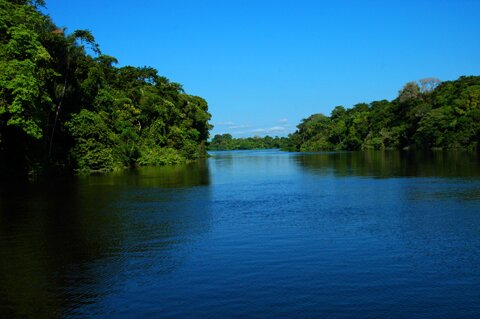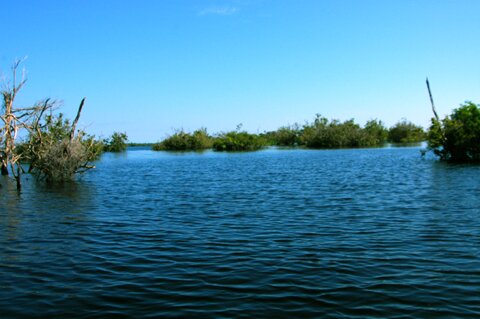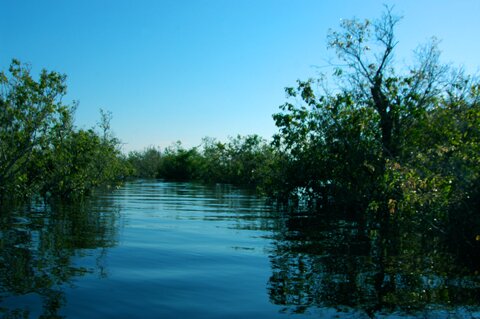Labor conflict paralyzes controversial hydropower projects in the Brazilian Amazon
Sergio Abranches
The Amazon hydropower work site at the Jirau dam, in the state o Rondonia, Northern Brazil, has been occupied by the military of the National Guard after 22,000 workers rebelled against poor work conditions. The works at its sibling Santo Antonio dam have stopped due to a sequence of 16,000 workers’ strikes. They are very controversial projects on all counts, but the government has remained aloof to the environmentalists’ criticism, to negative technical appraisals, and even to the skepticism of many investors.
The hydropower projects in the Amazon rivers are a good example of how not to use hydropower. They were decided autocratically by a group of politicians, technocrats, and contractors. Costs were underestimated by the winning bidders. Appraisals of environmental impact were technically flawed. A controversial special environmental licensing procedure is under judicial review. Social impact at the site and in the capital city of Porto Velho was grossly underestimated.
The two Madeira river plants, Santo Antonio and Jirau, are already under construction, and have been paralyzed by intense labor conflict. Belo Monte, to be built on the Xingu river, got a partial license to set up the construction camp which is also under judicial review. The contractor started to lay the groundwork for the camp, including significant logging of pristine Amazon forest, during carnival to minimize public attention.
Rebelled workers have set fire to the Jirau work camp, burning down sleeping quarters and a restaurant. Strikes had already paralyzed the Santo Antonio works on different occasions. One stoppage occurred immediately before the Jirau rebellion, and another right after the military of the National Guard occupied Jirau’s camp site. Workers complain about breach of labor contract; paid wages lower than what has been offered; a repressive work environment; and degrading work conditions. The contractors have denied all the complaints and said that workers have never told them about their dissatisfaction. Hard to believe. But there were recurrent signs of workers discontent. They were not taken into account neither by the government, nor by the contractors. Besides, worker’s stories collected by special envoys of the major Brazilian newspapers coincide with a well-known pattern of third party labor recruitment in the region. Offers of higher wages and benefits than they will really get are often used to lure workers from afar to these remote Amazon sites. Workers are recruited in other states, to work far from home. Large distances – sometimes thousands of kilometers – and difficulties imposed by employers to pay their travel back home and contractual rights on dismissal force them to stay.
What has really happened in Jirau? This is a story that only further investigation will uncover entirely. The authorities and employers say that the camp was raided by unknown vandals with their faces covered. This was the version the Federal Government has used to decide to send the military special unit, the National Guard, to intervene on what appeared to be a private conflict between workers and employers.
Tension was clearly on the rise in the Jirau camp. Both the contractors and the government should have been aware of that, since signs of discontent were present in several stories on the media. There is no record of any attempt at negotiation or arbitrage. The camp housed around 22,000 workers. Discontent among such a huge number of people enclosed together in a limited space, at a remote area, presents a clear and present danger of breaking into a hard to control riot. Contagion is immediate. Repression only aggravates existing grievances. After the riot was contained by military intervention, all workers were transferred to the city and piled up in a gym unfit to house that many people. No wonder a significant number asked to be paid off and get a ticket home. This has only started to happen after a judicial order forced the employers to comply.
The deterioration of urban life in Porto Velho was fast and could have been predicted by a appropriate professional analysis of social impact. Porto Velho has around 430,000 inhabitants. It received more than 38,000, mainly males, recruited from other states to work in the construction of the plants. The construction has attracted even more people. Residential rentals rose steeply. Porto Velho’s population increased by 12,5% from 2008, when works at the dams began, to 2010 reports the daily newspaper Folha de São Paulo (in Portuguese). The state of Rondonia’s population grew only 2.7% in the same period. The homicide rate increased 44%, and the number of infant and teenager victims of sexual abuse or prostitution rose 18%. Reported cases of rape have increased 76%. Drug trafficking has increased significantly.
These have been very controversial projects since the beginning. They’ll cost too much, depend on subsidized public finance, and have a yet unknown environmental impact. They are too far from consumption centers, requiring very long-distance and expensive transmission lines, crossing pristine tracts of the Amazon forest, with a significant rate of energy loss.
Nobody really knows the impact that changing the volume and flow of the river’s waters will cause to the flooded forest. A part of the affected forest is ‘flooded forest’, it remains under water for all the rain season. The Amazon has a very marked flood-drought regime, and part of plant and animal reproduction takes advantage of it. Seed dispersion is related to the water regime, as well as the food chain of several species.
I’ve crossed several kilometers of flooded forest by boat, negotiating my way through the canopy of trees as high as 35 meters. They were totally covered by water. I could only see the top of their canopy and it gave me the impression of going through bushes rather than being at the top of such high trees.
Analysis about the impact of the volume of organic sediment typical of the Amazon rivers has not been very convincing. Especially because the power plants will use bulb turbines of dimensions larger than any in use anywhere in the world. This technology has also never been adopted in rivers with the sediment characteristics of the Amazon rivers. This means that estimates of maintenance costs and average annual power yields are only hypothetical.
This is even more true for the Belo Monte project. The government says that Belo Monte is a 13,000 MW project, but its average annual yield will be around 4,000 MW in the best case scenario. During the worst days of the drought period it will stop generating power. Not even at peak production, during the flood season, actual yield will get even near installed capacity. Its actual efficiency rate will be much lower than the average yield of southeastern dams.
Negative social impact was grossly underestimated, as current events are clearly showing.
The original project for the Amazon dams was designed by the military government. It was an authoritarian and repressive regime. Environmental concerns were never taken into account. Neither was the economic and fiscal soundness of any project if national security concerns were at play. The occupation of the Amazon, ‘the green inferno’ how they used to call it, was considered a matter of national interest. Cost considerations were set aside, and the idea was to replace the forested area with human settlements. The same idea of ‘national interest’ has now been used by a judge to provisionally authorize construction pending a final ruling by the federal court.
The Lula government has restored and updated the Amazon projects, and has decided to implement them no matter what. On Dilma Roussef’s administration, Belo Monte got a ‘partial’ environmental license to allow building the work camp. The project itself has not been licensed yet because the contractors failed to fulfill all the precautionary conditions and offsetting imposed at the first stage of the licensing process. So, they started building a work camp for a project they don’t know whether or not will be licensed. It may a sign that the government intends to grant the final license irrespectively of the environmental precautions required.
The three projects are under judicial review. Licensing has been irregular and construction could likely be stopped by a final ruling. Now, in the case of Jirau, labor costs will rise significantly. First it is likely contractors will be sued by many workers asking for reparations. Second, new workers will ask for signed guarantees of wage levels, benefits, and work conditions prior to accepting replacing those leaving.
Before they started having labor problems, the Jirau contractors had already asked for more finance, as costs estimates increased from $ 5.4 billion to $ 7.8 billion.
Belo Monte’s originally estimated costs were $ 11.4 billion. But the state-owned development bank, BNDES, has already approved subsidized credit amounting to $ 15 billion, and some experts say final cost could be higher than $ 18 billion.
Taking into account the cost and energy efficiency of these projects, as well as their environmental impact, they are hardly justifiable. The same amount of energy could be produced using wind mills, for instance, in Northeastern Brazil, closer to consumption centers. The Northeast’s wind power potential is very high, even when considering only on-shore mills. It has the advantage of reaching peak production during the drought season, when the Southeastern’s hydropower plants’ reservoirs are at their lowest level. The environmental impact is negligible when compared to the Amazon projects. ROI is probably better, when taking into account real maintenance and transmission costs.
But wind power is not a part of the core of Brazilian energy policy. It belongs to a smaller, ancillary program for ‘alternative energy’. The core program only contemplates large hydropower plants; coal, oil, and gas fired thermal plants; and nuclear plants. Small hydro, biomass, wind, and solar, are set to contribute with a very small fraction of total electricity generation.
Tags: Amazon, Brazil, dam, energy, hydropower, renewable energy






Prezado Abranches, lendo este artigo me deparo com uma análise bastante clara e convincente. Não tenho intimidade com o assunto, que só agora me tem chamado a atenção, mas me assusta constatar que questões tão vitais para o conjunto social, ambiental e econômico de nosso país seja tratado com tamanha superficialidade e irresponsabilidade. Sem querer politizar a questão, mas fortes traços de arrogância e absolutismo encontra-se no processo decisório para a imposição do início das obras. É triste constatar que uma intervenção tão brutal e de consequências imprevisíveis no meio ambiente seja imposta de forma primitiva e irresponsável. A distância dos centros desenvolvidos dificulta o conhecimento e a consequente intervenção da sociedade neste processo.
Me parece que só nos resta a atuação do judiciário. Tenho acompanhado teus comentários sobre este assunto na CBN e te parabenizo pela competência e lucidez.